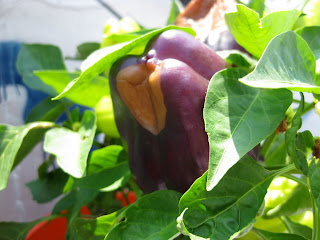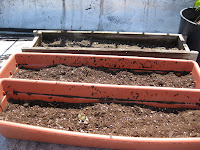
Most of our farm veggies are raised using fairly primitive methods. We dig holes by hand, avoid all synthetic fertilizers and herbicides, and harvest using nothing more than a pocket knife. The only motorized tool we use regularly is a rototiller.
But occasionally -- and by occasionally, I mean once or twice a season at most -- we bust out the big guns. When I first laid eyes on our transplanter I couldn't fathom what it was used for. It's actually pretty simple. There's a large wheel that divots holes in the ground. Water gets poured in from those big yellow tanks. And four people trail behind on chairs dropping plants seeded in the greenhouse into the holes. The two small children sitting on top are optional.
 It's kind of a comical scene, at least when we do it. Our tractor doesn't have a creeper gear, so we really have to rush to keep up. It's a lot like that scene from I Love Lucy in the chocolate factory, when Lucy and Ethel race to keep with the assembly line. At another farm I work at, the transplanter has a "six-shooter" -- sort of like a gun barrel where you throw the plants and they got shot into the ground, which helps move the whole process along smoothly.
It's kind of a comical scene, at least when we do it. Our tractor doesn't have a creeper gear, so we really have to rush to keep up. It's a lot like that scene from I Love Lucy in the chocolate factory, when Lucy and Ethel race to keep with the assembly line. At another farm I work at, the transplanter has a "six-shooter" -- sort of like a gun barrel where you throw the plants and they got shot into the ground, which helps move the whole process along smoothly.But even having to stop for catch-ups pretty regularly, and some quick covering up after the machine passes, the transplanter still creates the most perfect neat rows, and quickly.
The onions planted in that picture went in the ground and at the end of May and we just pulled them up a few weeks ago. You can't quite taste the straightness of the rows they grew in, but they were still pretty tasty.









 So what now? If the cukes keep on coming I will be experimenting with pickling, and I am super excited about it. Didn't you always think that it took a long time to turn something into a pickle? Apparently, it only takes a day or two.
So what now? If the cukes keep on coming I will be experimenting with pickling, and I am super excited about it. Didn't you always think that it took a long time to turn something into a pickle? Apparently, it only takes a day or two. 







































